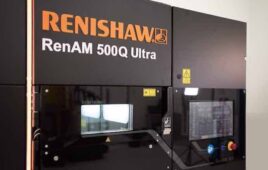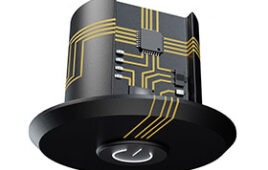The National Institute for Aviation Research (NIAR) at Wichita State University has expanded its capacities with the addition of several new pieces of equipment, including a professional grade metal additive manufacturing system and industrial-scale digital X-ray and 3D computed tomography system (X-ray CT).
Metal Additive Manufacturing System
The RPM INnovations 222 Standard System is a professional-grade system with powder-fed laser metal deposition technolgoy with 2 ft3 build capacity and a rotary table for cladding or building around a shaft.
The system, which was manufacutured in the United States, will be ready to take on client jobs by late July after routine installation, calibration and technician training.
“Additive Manufacturing has advanced dramatically in the last decade and permeated into just about every business sector,” said Paul Jonas, NIAR director of special programs. “The new RPMI system will enhance our capacity for prototyping, tool development and additive manufacturing research.”
NIAR performs industry-funded structural testing for additive manufacturing materials and parts, and works directly with multiple standards organizations in the development of guidelines to standardize the materials, processes and quality of additive manufactured parts.
Currently, NIAR is working with the FAA to develop the procedures and methodology necessary to include polymer additive manufactured materials in the NCAMP shared materials database. When completed in about a year, manufacturers will have the ability to obtain publically available design allowables for polymer-based additive manufactured materials, making it more economical and efficient to use the materials for aerospace applications.
“This is a very powerful enabler since NCAMP materials are recognized by the FAA, ESASA and all branches of the U.S. military,” said Jonas.
NIAR’s Additive Manufacturing Lab is home to multiple 3D printers including a BAAM (Big Area Additive Manufacturing) and additional capabilities ranging from simple prototypes to high-strength, high-temperature parts using fused deposition modeling (FDM), polyjet, direct laser metal sintering (DLMS) and full-color selective deposition lamination (SDL).
Industrial-Scale Digital X-ray and 3D Computed Tomography The X-ray CT is a multi-source (225/450 kV) and multi-detector comprehensive system used to inspect small and large objects up to five feet without sectioning. This inspection system is used to visualize interior features of solid objects, improving processes such as failure analysis, quality control, troubleshooting manufacturing issues, and the inspection of a variety of articles including additive-manufactured thick metallic structures to fiber fractures in composite laminates.
Computed tomography is a high-fidelity NDI technique that reconstructs 3D images of an object, including the internal surfaces and interior details, from numerous micron-level 2D digital radiographic projections using smart computer algorithms and high-performance computing power. Digital radiographic images are generated by 360° rotation of the object on a motorized stage, which is in between a micro-focus X-ray source and a detector. The real-time evaluation capability of CT with digital radiography increases productivity and eliminates the cost of consumables that are required during traditional X-ray. High-performance multi-threaded computing and novel reconstruction techniques enable production of dynamic volumetric 3D models that include time and motion (4D), which allows real-time inspections of a moving part.
This new capability was made possible through a Defense University Research Instrumentation Program of the Office of Naval Research (ONR). Waruna Seneviratne, technical Director of NIAR Composites Laboratory, was awarded $1.5 million for his proposal titled “X-Ray Computed Tomography for Nondestructively Inspecting Damage Initiation and Growth Mechanics of Composites and Bonded Joints under Fatigue Loading.”
Seneviratne was also awarded $2.3 million from ONR for his research proposals titled “Hybrid Test Setup for Investigating Scaling Effects of High-Cycle and Low-Cycle Fatigue Interaction on Fatigue Damage Progression of Composites” and “Material State Monitoring and Autoclave Control System for Validating Models for Detecting Process-Induced Damages in Polymer Composites.” These programs will provide valued information to ONR and allowed for the purchase of several high-fidelity inspection systems such as a high-speed multi-channel acoustic emission system for in-situ failure detection and a mobile autonomous scanner (MAUS) for rapid wide-area ultrasonic and eddy-current inspections.
Filed Under: 3D printing • additive • stereolithography, Industrial automation




